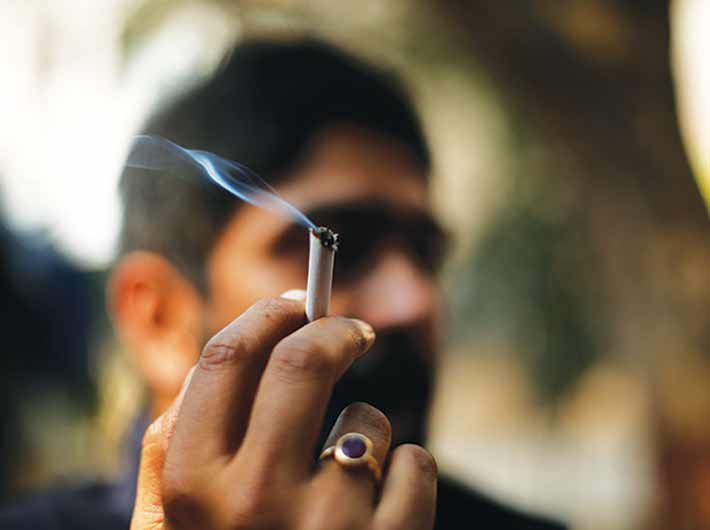(This article was written before the Budget 2016 was announced, which increased excise duty on all tobacco products by 10-15%)
A report released in February says that tobacco products in the country have become more affordable than essential food items in the last decade. Titled ‘Tobacco taxes in India: An empirical analysis’, it adds to the evidence supporting the government’s lackadaisical attitude in controlling tobacco consumption in the last one year which saw the government deferring bigger pictorial warnings on tobacco products.
The report, commissioned by the ministry of health and family welfare (MoHFW) and the world health organisation (WHO), analysed the annual increase in taxes on cigarettes, beedis and all forms of chewing tobacco vis-a-vis an increase in the wholesale price index (WPI) of 46 essential food items such as wheat, milk, pulses, fruits and vegetables from 2006 to 2013. It also compared the price increase in tobacco products with the growth of per capita income.
It finds that though taxes on tobacco products increased every year, their rise was miniscule when adjusted for inflation. “Even though taxes are increased on tobacco products every year, when this tax increase is adjusted to the base year, then the increase is not too much. In real terms, the tax burden has actually gone down,” says Sarit Kumar Rout, associate professor at the Public Health Foundation of India (PHFI), who co-authored the report with Shailender Kumar Hooda, associate professor at the Institute for Studies in Industrial Development.
By their calculations, tax burden on cigarettes declined from 55.3 percent in 2008 to 36.8 percent in 2013. For beedis, it went down from 7.2 percent in 2011 to 5.3 percent in 2013.
Taxes on production of tobacco products are levied through central excise duty and value added tax on the products’ wholesale and retail prices, which could differ from state to state. Tobacco products also attract surcharges or cesses such as beedi welfare cess.
Increasing taxes on tobacco products is considered one of the most effective strategies globally to reduce their consumption. While India has pictorial warnings on all tobacco products and a ban on their advertisement, in the area of taxation there is a huge gap, says K Srinath Reddy, president, PHFI.
In 2008, a study conducted by Riju John, assistant professor of economics at the IIT, Jodhpur, showed that a 10 percent rise in the prices of beedis in India led to a 9.2 percent fall in its consumption in rural areas and 8.5 percent drop in urban areas.
As per the global adult tobacco survey (GATS) 2010 conducted by WHO, 35 percent of adult population in India consumes tobacco in some form or the other. India is also the second largest consumer and third largest producer of tobacco in the world.
“One million Indians die of tobacco use every year. Ninety percent of oral cancer cases in Indian men are due to chewing of tobacco. This is absolutely unacceptable. Why is India failing in tobacco taxation? Is there too much economic interest? And by whom?” asks Henk Bekedam, WHO representative to India.
WHO recommends at least 70 percent of retail prices to be taxed on tobacco products. Currently, only 43.7 percent of the retail price is charged as tax on tobacco products in India. In Pakistan, this stands at 46.17 percent while in Thailand, Sri Lanka and Bangladesh, it is 66.59, 63.07 and 61 percent respectively.
Bekedam adds that increased taxes on tobacco products are a win-win situation for the government. “There is nothing about the tobacco industry that is commendable. For them, it’s business. But we can fight the business that is killing people.” By not taxing these firms, he says, “We are not just losing revenue, we are losing people.”
Health economists, too, agree that the rise in tobacco taxes should be higher than inflation. Between 1990-91 and 2012-13, data from the finance ministry shows that more than 75 percent of total revenue of tobacco products was earned from cigarettes, but data from the national sample survey organisation and the annual survey of industries shows that cigarettes contributed only 42 percent of the total output of the smoking industry (which also includes beedis).
Similar data sources show that beedis provide five percent of total revenue earned from tobacco products but generate 58 percent of total output in the smoking industry. The chewing tobacco gives seven percent of total revenue earned from tobacco products and equal percentage of output.
Meanwhile, a representative from MoHFW said that the ministry has little control over fixing the tax rate as it is the mandate of the finance ministry. “There are vested interests in tobacco industry. We are facing legal challenges from every quarter. It is keeping us busy throughout the year,” he said.
The report, which has been presented to the finance ministry ahead of Budget 2016-17, supports the findings of WHO’s global tobacco epidemic 2015 report which had stated that cigarettes have become more affordable in India during 2008-14.
It recommends a simplified, uniform tax structure for all tobacco products across all states as the current system is complex and gives tobacco companies leeway to evade taxes by manipulating with product design and branding, while staying well within the law. For instance, different lengths of cigarettes and whether they have filters or not are taxed differently. Cigarette manufacturing companies also have several brands. When taxes are increased, the price of their most popular brand is increased slightly and modifications are made accordingly in their other brands. This way, companies prevent an increase in taxes affecting their sales and profits, and retain their customers. The study wants taxing cigarettes based on their length to be eliminated in a phased manner.
Similarly, beedis largely fall outside the ambit of taxes as many beedi manufacturing companies are home-based and not registered. A manufacturer producing less than two million beedis annually is exempted from paying taxes. Hand-made and machine-made beedis are taxed differently. Taxes on smokeless tobacco, available in the form of gutkha and khaini among others, are levied based on the capacity of the machines operating in the factories.
“The complicated tax structures help the industry more than the people. The companies preserve their customers by launching multiple brands. It is legal and we are enabling them to do it because of our distorted tax system,” says John. While MoHFW recognises the complex tax structure, it admits that having a single slab of taxes for products that are priced differently is difficult. “How can we have uniform taxation when price of tobacco products ranges from '2 to '100?” asks Jagdish Kaur, chief medical officer (tobacco control) at MoHFW.
A 2014 study by MoHFW titled ‘Economic burden of tobacco related diseases in India’ estimates that the economic cost of treating diseases caused due to tobacco consumption in 2011 was a whooping '1,04,500 crore. This is 1.04 percent of India’s gross domestic product (GDP). Ironically, roughly the same figure is allocated to the health sector in the country’s annual budget.
The report also recommends eliminating exemptions of tobacco products in the unorganised sector, indexing tax increases on tobacco products with inflation to ensure that there is a real increase in the price of tobacco products with tax increase, and charting a uniform VAT across all states.
It, however, does not analyse the impact of the increased affordability of tobacco products on its consumption patterns. The picture will become clearer with the next round of GATS scheduled to be held this year.
sonal@governancenow.com
(The article appears in March 1-15, 2016 issue)

